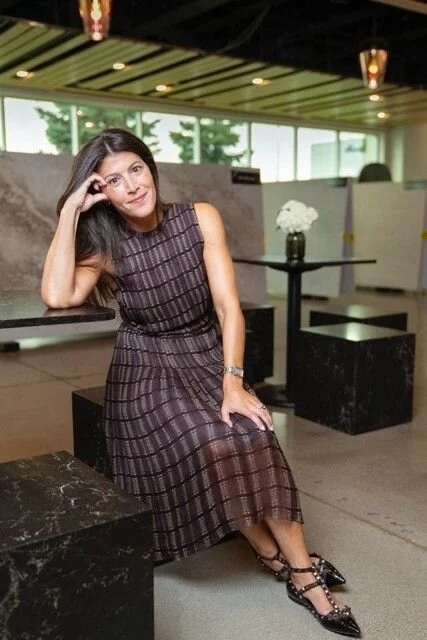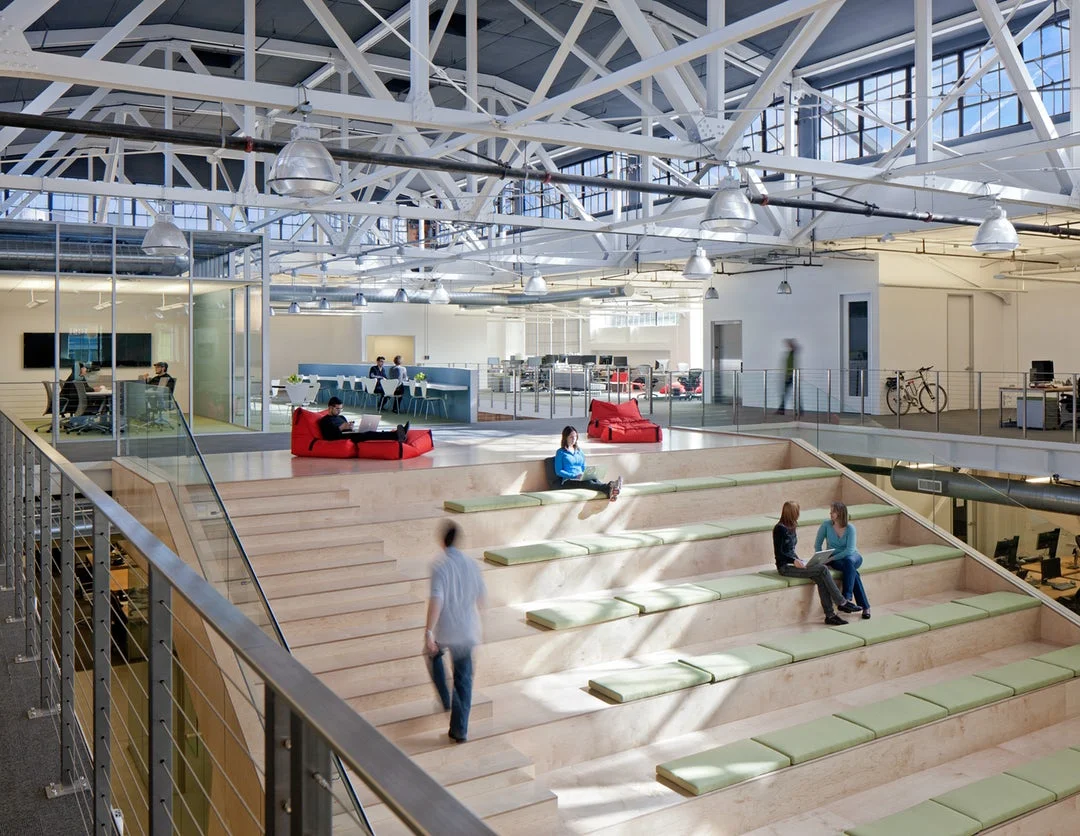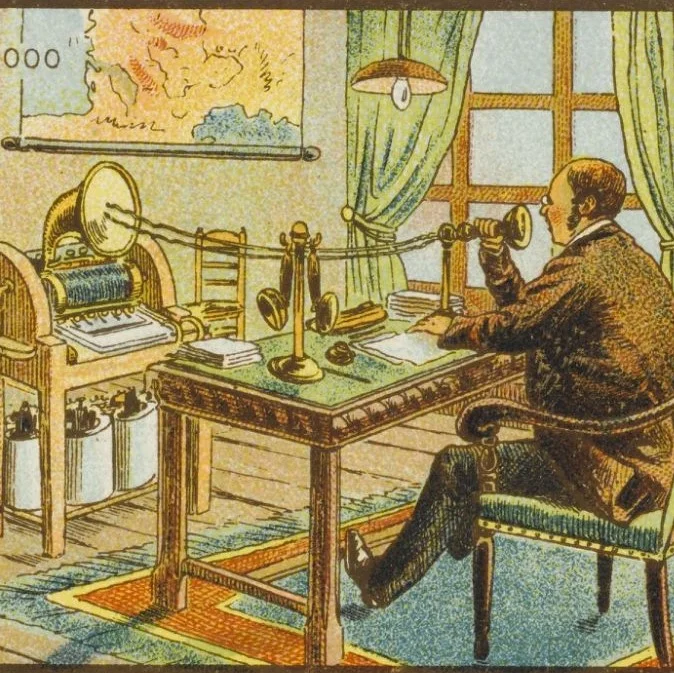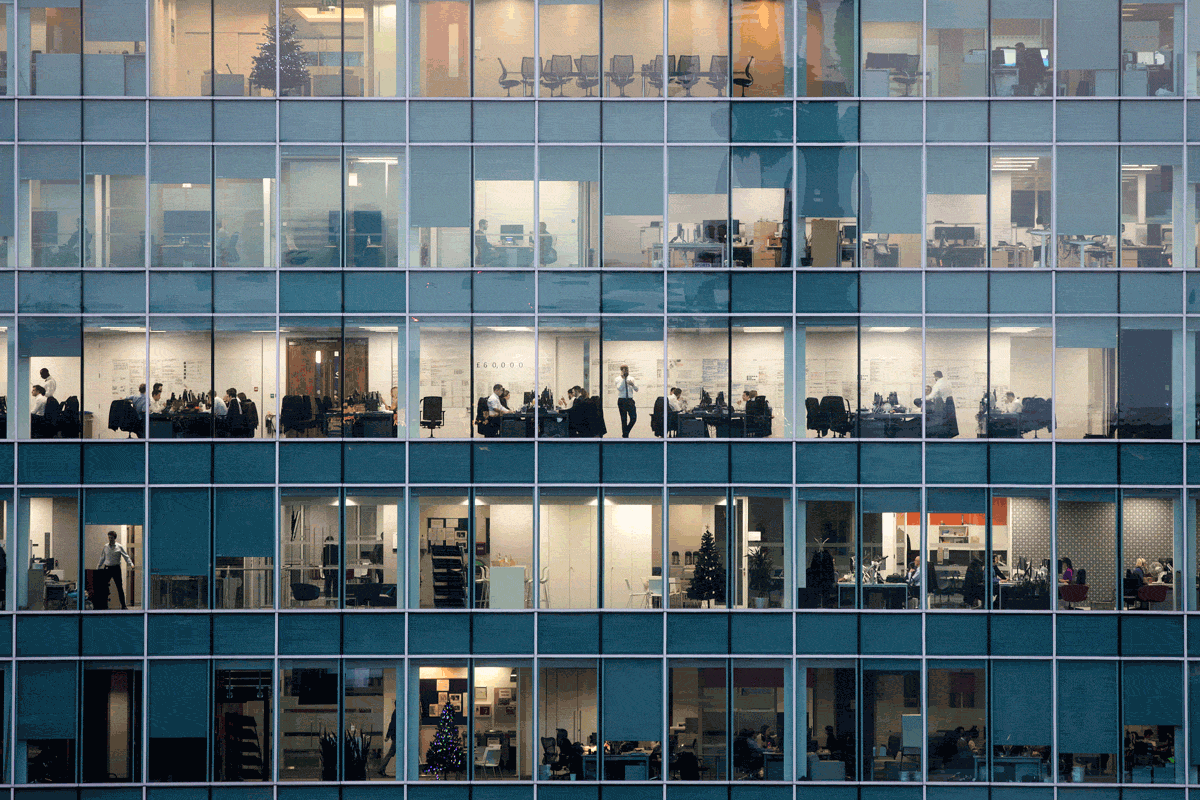Once upon a time, an organization wanted to appeal to new and existing clients, while inspiring both employees and recruits. They had an excellent product, offered quality service, and leveraged its brand power well through its public persona. The one place it hadn’t considered as part of its brand arsenal was its own workplace
Functional Flexibility: 7 Terraced Staircases Imagined for Communal Gathering
Have you ever been called to a meeting room only to arrive in an underwhelming cube, where you immediately begin to shuffle chairs around like bumper cars? And after all that kerfuffle, there still remains one isolated worker standing in the corner, without a car of their own to park around the table. While not disastrous on any scale, these repetitive and sometimes awkward encounters are avoidable, and largely delineated by an unsuitably executed built environment. Such situations — whether similarly inconsequential or more cataclysmic — are simple indications that good architectural and design interventions, are essential in our everyday work environments.
If you really want to get to know your colleagues, lock yourselves in a room together
Trust falls are passé. Paintball leaves bruises. The best way to bond with coworkers now is doing an “escape room,” a game in which participants are given a set amount of time (usually an hour) to solve a series of puzzles and free themselves from a locked space. A theme or conceit gives the game urgency—players are told they have an hour before a killer virus wipes out their city, for example, or they must break out of prison before the warden returns. One particularly meta room in Florida has corporate participants escape from an office.
Culture Chat: The Overlooked Connection Between Collegiate Design and Workplace Culture
This is the first of a new series of Culture Chat conversations, in which we talk with people doing interesting work that has an unexpected connection to workplace culture. In this episode, we chat with Jonathan Webb and Brett Shwery, the authors of this fascinating study about the lessons companies can learn from how the next generation of workers interact in a college
Standing desks and the rise of 'healthy design'
If you’ve been inside any workplace renovated within the last few years, you’ve probably noticed that once-ubiquitous private offices are giving way to open floor plans with a variety of spatial configurations, from desk clusters to counters to lounge seating. At the same time, architects and clients are finding common ground in designing for health, embracing that the places in which we work can help or hinder our wellbeing.
BSRIA launches Workplaces of the Future report
BSRIA has launched its Workplaces of the Future publication which contemplates the office needs and desires from the perspective of the youth of today aka millennials and Generation Z.
The report also claims that the office of the future may not even need to be a workplace in the accepted sense of the word. With new and more advanced mobile devices, giving employees the freedom to work from anywhere, these technologies, it says will continue to reshape the look and feel of the ‘office’.
May 19, 2017 Working from home and the future of work. How quaint
In 1962, a professor of communication studies called Everett Rogers came up with the principle we call diffusion of innovation. It’s a familiar enough notion, widely taught and works by plotting the adoption of new ideas and products over time as a bell curve, before categorising groups of people along its length as innovators, early adopters, early majority, late majority, and laggards. It’s a principle bound up with human capital theory and so its influence has endured for over 50 years, albeit in a form compressed by the accelerated proliferation of ideas. It may be useful, but it lacks a third dimension in the modern era. That is, a way of describing the numbers of people who are in one category but think they are in another.
Work-Life Balance Is More Important Than Salary [Infographic]
Despite its status as one of the most famous rambling of a psychotic killer, “All work and no play makes Jack a dull boy,” is an important mantra to live by, especially when working at a startup. Burning the midnight oil and foregoing sleep for a little extra productivity is not only ill-advised, but also ill-conceived, as it has been proven time and time again that working tired simply isn’t worth it. So what’s the best way to make sure your employees don’t burn out? Make a commitment to work-life balance.
Home workers more likely to sustain work-related injuries than people based in offices
Today (Friday 19th May) is National Work from Home Day, held to promote the benefits of home working, which includes having more time to take exercise and eating more healthily; but new research suggests home workers might risk doing more harm than good if too little attention is paid to ergonomics. The data from Bupa found that over half of home-workers (51 percent) have sustained injuries, aches and pains as a result of their working environment with the most common being backache and neck pain, which is 10 per cent more likely than those working in a ‘traditional’ workplace. Not having the right work set-up at home could be the cause, as one in four (25 percent) home-workers do not have a dedicated workspace at home, half (50 percent) of admit to hunching over while working and 40 per cent regularly work from their bed or sofa. All of these factors increase the risk of musculoskeletal injury, with the most common problems being backache (24 percent) and neck-ache (20 percent).
Quarter of UK workers would move jobs for office with a better mobile signal
One in four (25 percent) of British office workers say they would consider moving jobs (or have already moved) due to a lack of mobile coverage in their building, claims new research from Arqiva, which highlights the worrying extent of the UK’s struggle for adequate indoor mobile coverage and its potential impact to businesses in the future. The survey, conducted among 1,000 UK office workers, revealed that as many as 1 in 2 (49 percent) respondents have experienced poor mobile coverage (i.e. dropped calls or a lack of signal) within their office building. Of those, almost three quarters (72 percent) say this is an occurrence that happens every week, and a quarter (25 percent) say it is something they face daily.
View: On - Zurich, Switzerland
On, the young, successful running shoe brand, keeps employees on their toes in the company's new headquarters in Zurich: while working environments usually seek to shorten paths, the On team moves around along a central aisle in an office space of over 100 metres. There are no partitions or attributed workspaces. Employees clock up a total distance of two to three kilometres daily in a setting that promotes intercommunication unlike any conventional office layout. This dynamic environment thrives on emotions and calls for a sense of comfort and well-being – for sofas which are at home in offices and office chairs that are also perfect for the home office. Cross-functionality is part and parcel of Vitra's comprehensive product portfolio, which is why the On office is furnished entirely with Vitra furniture.
Inside the Offices Where the Music Never Stops and Everyone Is DJ
The rise of the open-floor-plan office has exposed workers to many annoying habits that used to hide behind cubicle walls, from distracting personal phone calls to weird food smells. Now, at least within an emerging vanguard of music-friendly offices, add coworkers' musical preferences to that list.
Sickness causing germs at the office desk mainly due to poor personal hygiene
The number of sick days taken by office workers could be reduced if companies implemented a better cleaning routine and staff improved their personal hygiene, finds a new academic study. The workplace is ranked as one of the unhealthiest places you’re likely to inhabit on a daily basis, says Dr Lisa Ackerley, hygiene expert and visiting professor at the University of Salford, whose study revealed that the main cause of germs at the desk and keyboard is poor personal hygiene, with nearly 50 percent of office workers responding to her survey admitting they do not wash their hands after going to the toilet. Your hands and the surfaces you touch, including your office chair are germ motorways, she warns. Crumbs and spills encourage the growth of bacteria that can lead to stomach bugs, coughs, flu and even food poisoning. Bacteria and viruses that people bring back from the toilet multiply on the hard work surfaces of the desk and chair and remain infectious for 24 hours.
ONE MORE THING INSIDE APPLE’S INSANELY GREAT (OR JUST INSANE) NEW MOTHERSHIP
ON JUNE 7, 2011, a local businessman addressed a meeting of the Cupertino City Council. He had not been on the agenda, but his presence wasn’t a total surprise. Earlier in the year the man had expressed his intention to attend a meeting in order to propose a new series of buildings along the city’s northern border, but he hadn’t felt up to it at the time. He was, as all of them knew, in dire health.
Technology Driven Spaces Designed to Fuel Creativity and Innovation In The Workplace
We are now in a time where the workplace is experiencing unprecedented change. As we continue to explore these changes and take a closer look at the ways the corporate work environment has distinctly evolved, we must also consider the benefits in transforming the ways in which we work. Research shows that the work environment can support the rise or decline in productivity, connectedness, and creativity based on its design and structure. Creativity has become a preeminent necessity in the modern workplace, leaving employers to reexamine how they’re prioritizing employee innovation.
The Outdoor Office Spaces Where Workers Commune with Nature
From al desko to al fresco. Outdoor office spaces are popping up around the globe – but would you regularly take your business outside?
Meditating on workplace design with Studio O+A
Incorporating a space that can spark moments of interaction, such as a social hub by the coffee machine, is often at the fore when designing new workplaces. At this year's Salone del Mobile presenting a new scenario for offering 'moments of meditation around the water cooler', Studio O+A's interactive installation investigated future work environments.
A new approach to office design is redefining our relationship with property
At the end of the 18th Century it was becoming apparent that overpopulation was something the human race would need to address for perhaps the first time. Advances in technology and the urbanisation that followed the Industrial Revolution had created a new set of challenges. These were most famously laid out in a 1798 book called An Essay on the Principle of Population, written by an English cleric called Thomas Malthus. The book helped to influence the nascent discipline of economics and informed the thinking of Charles Darwin when he wrote On The Origin of Species some sixty years later. The term Malthusian remains in use to this day when describing the central paradox laid out in the book. This paradox suggests that because population increases geometrically (doubling every 25 years by multiplication), while food production only grows arithmetically (by addition), the end result can only be depressed wages and ultimately starvation.
6 Absurd (And Kinda Brilliant) Design Details From Apple Park
Anyone following the $5 billion product development known as Apple Park–the company’s new 175-acre development on which a 2.8-million square foot Norman Foster spaceship has officially landed–will want to read the latest feature in Wired, which takes the closest look yet at the “insane” attention to detail within the campus.
CRE Opinion: Real Estate and Psychology? Please Have a Seat on My Couch.
You may want to familiarize yourself with the term ‘biophilia’—it can translate to a huge benefit to a company’s bottom line.













![Work-Life Balance Is More Important Than Salary [Infographic]](https://images.squarespace-cdn.com/content/v1/55b25edee4b00a6772a63fc6/1495215092131-CLAU0U6N8M5ONYTRP0V6/Screen+Shot+2017-05-19+at+12.31.11+PM.png)











